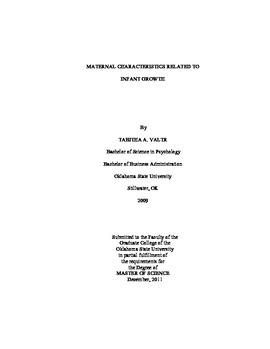| dc.description.abstract | The purpose of this thesis was to evaluate links among maternal characteristics, maternal feeding patterns, and infant growth. Maternal characteristics included parenting styles and attitudes, stress, and affect. Mother-infant dyads (N=111) were recruited from the general population in a rural community. Dyads visited the laboratory when infants were 3, 6, and 9 months (mos.). Maternal measures included the Positive and Negative Affect Scale (PANAS), Symptom Checklist-90-Revised (SCL-90-R), Parenting Styles and Dimensions Questionnaire, Parenting Stress Index - Short Form, and Adult Adolescent Parenting Inventory - 2. Infant measures included anthropometric measures and amount of formula. Primary measure of infant weight was weight per day gain (wt-d-gain) to control time between visits. Correlation, regression, and ANOVA analyses tested the five hypotheses and two research questions. Correlations confirmed hypothesis I that as daily formula at 6 and 9 mos. increased, wt-d-gain from 6 to 9 mos. increased, r = .204, p = .016 and r = .246, p = .005. The 71 infants who received no formula at 9 mos. had lower wt-d-gain from 6 to 9 mos. F (1, 109) = 8.022, p = .006, than the 40 infants who received some formula. The ANOVA for hypothesis II compared 3- to 6-mo. rapid weight gain (> .67 SD versus < .67 SD) groups on the dependent variable of 9-mo weight. Infants > .67 SD weight gain had higher 9-mo weight (M = 9.1945, SD = 1.07293) than infants < .67 (M = 8.6710, SD = 1.00773), F (1, 109) = 6.022, p = .016. For hypothesis III, 3- to 9-mo wt-d-gain was predicted by SCL90-R Somatization, R2= .049, β = -.002, p = .039. Infant wt-d-gain from 6 to 9 mos. and 3 to 9 mos. were predicted by birth order X depressive symptoms. In opposition to hypothesis III: for later-born children, the higher the maternal depression, the lower the child wt-d-gain. Hypotheses IV (higher maternal insensitivity is associated with greater wt-d-gain) and V (permissive parenting is associated with greater wt-d-gain) were not supported. The ANOVA for research question I revealed gender differences in wt-d-gain from 3 to 6 mos., F (1,109) = 4.435, p = .039, and 3 to 9 months, F (1, 109) = 9.894, p = .002. Analyses of research question II found no significant correlation between authoritative or authoritarian style and wt-d-gain. There was a correlation between permissive style and amount of formula at 6 and 9 mos., r = .262, p = .008 and r = .196, p = .048, respectively. | |
